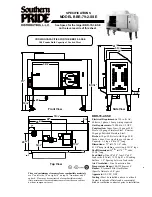
e1276e
3
Siemens Building T
echnologies
Cerberus Division
09.2000
1.3
Operating principle
The linear smoke detector operates on the basis of the extinction principle, i.e. the reduc-
tion in light intensity due to smoke is measured. The transmitter (IRED) emits a strongly
focused infrared light bundle along the optical measuring section. Without smoke a large
part of the beams attains the reflector and is sent back in the same direction toward the
receiver. The arriving light produces an electrical signal on the photodiode of the receiver.
Receiver
Transmitter
Measuring section
Reflector
Detector
Fig. 1
Linear smoke detector without smoke
If smoke penetrates the measuring section, part of the light beams is absorbed by the smoke
particles while another part is scattered by the smoke particles, i.e. the light beams merely
change direction. The remaining light reaches the reflector. The remaining light is then reflec-
ted and once again passes through the measuring section and is further attenuated. Thus only
a small portion of the beam reaches the receiver and the signal (S
smoke
) becomes smaller.
Smoke particles
Scattering
Scattering
Scattering
Light beam
Residual light
Absorption
Fig. 2
Measuring principle of the linear smoke detector with smoke
Extinction = Abso Scattering








































